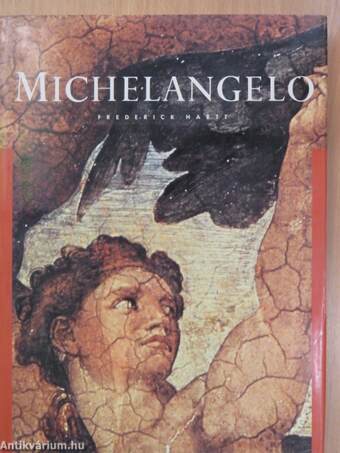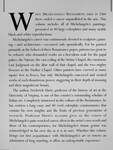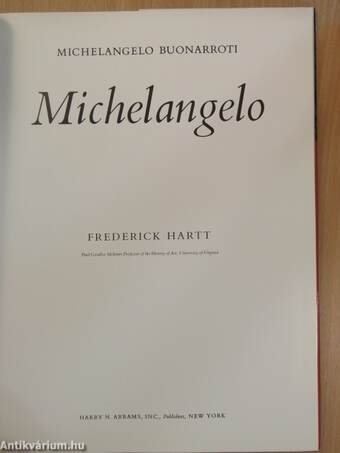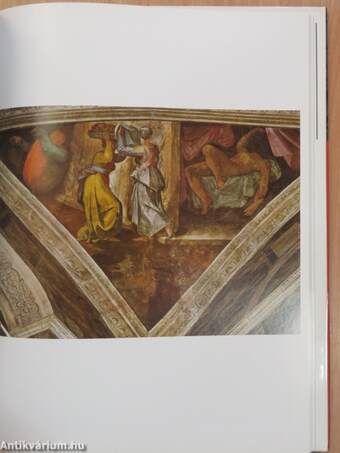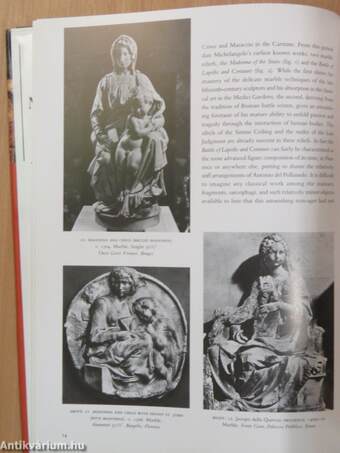1.117.329
kiadvánnyal nyújtjuk Magyarország legnagyobb antikvár könyv-kínálatát
Michelangelo
| Kiadó: | Harry N. Abrams, Inc |
|---|---|
| Kiadás helye: | New York |
| Kiadás éve: | |
| Kötés típusa: | Vászon |
| Oldalszám: | 128 oldal |
| Sorozatcím: | |
| Kötetszám: | |
| Nyelv: | Angol |
| Méret: | 31 cm x 24 cm |
| ISBN: | 0-8109-1335-6 |
| Megjegyzés: | Színes reprodukciókkal. |
naponta értesítjük a beérkező friss
kiadványokról
naponta értesítjük a beérkező friss
kiadványokról
Fülszöveg
When Michelangelo Buonarroti died in 1564
there ended a career unparalleled in the arts. This
volume includes all of Michelangelo's paintings,
presented in 40 large colorplates and many sizable
black-and-white reproductions.
Michelangelo's career was continuously devoted to sculpture; paint-
ing—and architecture—occurred only sporadically. For he painted
primarily at the behest of three Renaissance popes, patrons too great to
be refused, who demanded works on a herculean scale for the papal
palace, the Vatican: the vast ceiling of the Sistine Chapel, the enormous
Last judgment on the altar wall of that chapel, and the two mighty
frescoes in the Pauline Chapel. Other painters have covered as many
square feet in fresco, but only Michelangelo conceived and created
works of such thunderous power, staggering in their depth of meaning
and their magnificent beauty.
The author, Frederick Hartt, professor of the history of art at the
University of Virginia, is one of this... Tovább
Fülszöveg
When Michelangelo Buonarroti died in 1564
there ended a career unparalleled in the arts. This
volume includes all of Michelangelo's paintings,
presented in 40 large colorplates and many sizable
black-and-white reproductions.
Michelangelo's career was continuously devoted to sculpture; paint-
ing—and architecture—occurred only sporadically. For he painted
primarily at the behest of three Renaissance popes, patrons too great to
be refused, who demanded works on a herculean scale for the papal
palace, the Vatican: the vast ceiling of the Sistine Chapel, the enormous
Last judgment on the altar wall of that chapel, and the two mighty
frescoes in the Pauline Chapel. Other painters have covered as many
square feet in fresco, but only Michelangelo conceived and created
works of such thunderous power, staggering in their depth of meaning
and their magnificent beauty.
The author, Frederick Hartt, professor of the history of art at the
University of Virginia, is one of this country's outstanding scholars of
Italian art. Completely immersed in the culture of the Renaissance, he
has written a long essay and 40 vivid colorplate commentaries that
contain his own insights and the fruits of previous generations of
research. Professor Hartt's account gives us the course of
Michelangelo's pain-wracked career, often in the artist's own words and
those of his contemporaries, for Michelangelo's titanic genius was
acknowledged in his own day as it is in ours. Whether this volume
brings our first acquaintance with Michelangelo's art or renews an
admiration of long standing, it offers an unforgettable experience. Vissza
Témakörök
- Idegennyelv > Idegennyelvű könyvek > Angol > Művészetek > Festészet
- Művészetek > Festészet > Korszakok, stílusok > XV. század - Reneszánsz > Egyéb
- Művészetek > Festészet > Idegen nyelv > Angol
- Művészetek > Festészet > Tanulmányok, összefoglalók > Külföldi
- Művészetek > Festészet > Albumok > Külföldi festők
Frederick Hartt
Frederick Hartt műveinek az Antikvarium.hu-n kapható vagy előjegyezhető listáját itt tekintheti meg: Frederick Hartt könyvek, művekMegvásárolható példányok
Nincs megvásárolható példány
A könyv összes megrendelhető példánya elfogyott. Ha kívánja, előjegyezheti a könyvet, és amint a könyv egy újabb példánya elérhető lesz, értesítjük.


